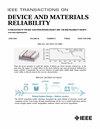4H-SiC雪崩光电二极管单事件烧蚀分析
IF 2.3
3区 工程技术
Q2 ENGINEERING, ELECTRICAL & ELECTRONIC
IEEE Transactions on Device and Materials Reliability
Pub Date : 2025-07-30
DOI:10.1109/TDMR.2025.3593916
引用次数: 0
摘要
本文给出了碳化硅雪崩光电二极管(APD)中重离子诱导的单事件泄漏电流(SELC)衰减和单事件燃烬(SEB)的二维数值模拟结果。所采用的模拟物理模型和材料参数通过反I-V特性和光谱响应特性在实验中得到验证。确定了对重离子最敏感的区域。然后,研究了SiC APD的SEB失效行为。在分析离子诱导SELC降解或SEB失效的基础上,研究了三种硬化方法:改变台面蚀刻深度、引入低载流子寿命控制区(LCLC)和插入缓冲层。比较了三种硬化方式对SiC APD电学性能和SEB性能的影响。本文章由计算机程序翻译,如有差异,请以英文原文为准。
Analysis of Single-Event Burnout in 4H-SiC Avalanche Photodiode
This paper presents the 2-D numerical simulation results of the heavy-ion-induced single-event leakage current (SELC) degradation and single-event burnout (SEB) in the silicon-carbide (SiC) avalanche photodiode (APD). The employed simulation physics models and material parameters are validated by the reverse I-V characteristics and spectral response characteristics in experiments. The region most sensitive to heavy ion is identified. Then, the SEB failure behavior of SiC APD is investigated. Based on the analysis of ion-induced SELC degradation or SEB failure, three hardening methods–modifying the mesa etch depth, introducing Low Carrier Lifetime Control (LCLC) region, and inserting buffer layer–are investigated. As a result, the effects of three hardening methods on the electrical properties and SEB performance for SiC APD are compared.
求助全文
通过发布文献求助,成功后即可免费获取论文全文。
去求助
来源期刊

IEEE Transactions on Device and Materials Reliability
工程技术-工程:电子与电气
CiteScore
4.80
自引率
5.00%
发文量
71
审稿时长
6-12 weeks
期刊介绍:
The scope of the publication includes, but is not limited to Reliability of: Devices, Materials, Processes, Interfaces, Integrated Microsystems (including MEMS & Sensors), Transistors, Technology (CMOS, BiCMOS, etc.), Integrated Circuits (IC, SSI, MSI, LSI, ULSI, ELSI, etc.), Thin Film Transistor Applications. The measurement and understanding of the reliability of such entities at each phase, from the concept stage through research and development and into manufacturing scale-up, provides the overall database on the reliability of the devices, materials, processes, package and other necessities for the successful introduction of a product to market. This reliability database is the foundation for a quality product, which meets customer expectation. A product so developed has high reliability. High quality will be achieved because product weaknesses will have been found (root cause analysis) and designed out of the final product. This process of ever increasing reliability and quality will result in a superior product. In the end, reliability and quality are not one thing; but in a sense everything, which can be or has to be done to guarantee that the product successfully performs in the field under customer conditions. Our goal is to capture these advances. An additional objective is to focus cross fertilized communication in the state of the art of reliability of electronic materials and devices and provide fundamental understanding of basic phenomena that affect reliability. In addition, the publication is a forum for interdisciplinary studies on reliability. An overall goal is to provide leading edge/state of the art information, which is critically relevant to the creation of reliable products.
 求助内容:
求助内容: 应助结果提醒方式:
应助结果提醒方式:


